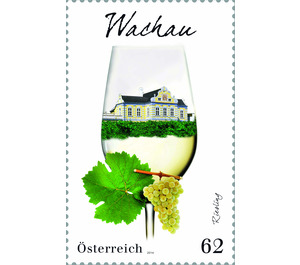wine regions - Austria / II. Republic of Austria 2014 - 62 Euro Cent
Theme: Cuisine & Groceries
| Country | Austria / II. Republic of Austria |
| Issue Date | 2014 |
| Face Value | 62.00 |
| Edition Issued | 700,000 |
| Printing Type | offset |
| Stamp Type | Commemorative |
| Item Type | Stamp |
| Chronological Issue Number | 2470 |
| Chronological Chapter | OOS-OE2 |
| SID | 332707 |
| In 63 Wishlists | |
Gentle hills meet steep terraces, flowering orchards are lined with historic pens, palaces and castles, charming villages invite you for a walk and take care of your physical well-being - so you know and love the Wachau, which is not by some UNESCO World Heritage. The special stamp "Wachau" presents this unique river landscape between Melk and Krems, which has always provided people with a fertile and inspiring habitat and produced Austria's most famous wines. The wine culture of the Wachau dates back to the first century BC, when the area was settled by the Romans. In the Middle Ages, the wines of this region were already well known far beyond the country's borders. Today, mainly white wines are cultivated on an area of about 1,350 hectares, the special climate and the soils of the river landscape together with the great expertise and experience of the winemakers form the recipe for success of the Wachau wines. Here, the Atlantic temperate air meets pannonic warm air and cool down winds from the Waldviertel, and this interplay creates a microclimate that varies depending on the slope and terrain. The barren primeval soil, which is crossed by loess islands and in the direction of the river in a sandy soil, provide for the rather low fruit set of the vine, which in turn makes the unique flavor intensity of the Wachau wines. In 1983, the Vinea Wachau Nobilis Districtus was founded, an association of winegrowers, which cultivates about 85 percent of the Wachau winegrowing area with its now almost 200 members. The proven origin, the natural wine production and a strict self-control belong to the highest directives of the Vinea Wachau and make it a worldwide guarantor for highest wine quality. Their top wines are divided into three brands depending on the alcohol content: The "Steinfeder" has a maximum alcohol content of 11.5% by volume, the "Federspiel" allows an alcohol content of up to 12.5% by volume. The most valuable wines of the Vinea Wachau are called "emerald", these have an alcohol content of over 12.5 vol .-% on. The special stamp "Wachau" is especially dedicated to the Riesling, which, along with the Grüner Veltliner, is one of the best-known wine varieties in the region and is often referred to as the "king of white wines". The pictured baroque Kellerschlössel in Dürnstein belongs to the wine cooperative "Domäne Wachau", which manages one of the oldest wineries in Austria and the largest of the Wachau. The Kellerschlössel was built in the years 1714 to 1719 and is a popular landmark in the middle of the picturesque cultural landscape.


